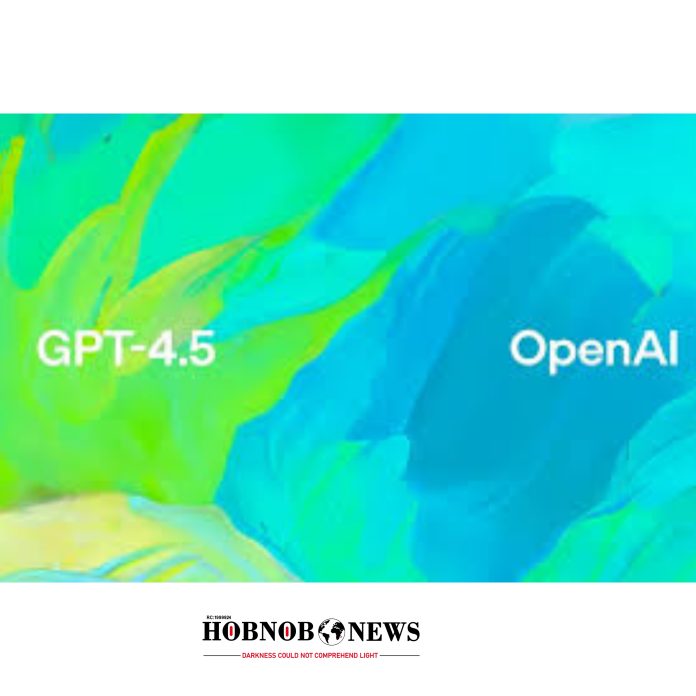OpenAI has officially introduced GPT-4.5, the latest version of its flagship large language model, which the company claims is its most advanced and well-rounded chat model to date. “It’s really a step forward for us,” said Mia Glaese, a research scientist at OpenAI.
Following the release of OpenAI’s reasoning models, o1 and o3, the company has been developing two distinct product lines. GPT-4.5 falls under the non-reasoning category, which Nick Ryder, another research scientist at OpenAI, describes as “an installment in the classic GPT series.”
Those subscribed to OpenAI’s $200-a-month ChatGPT Pro plan can start using GPT-4.5 immediately. The company has announced plans to gradually roll out access to other users in the coming week.
Over the last few iterations of OpenAI’s GPT models, there has been a trend where larger models tend to perform better. However, there is growing skepticism about whether increasing model size will continue yielding significant improvements. Even OpenAI’s former chief scientist, Ilya Sutskever, has questioned this approach. Despite these concerns, OpenAI’s promotion of GPT-4.5 suggests that it remains confident in scaling up its models.
Like all large language models, GPT-4.5 identifies patterns in the vast amounts of data it has been trained on. Smaller models typically recognize basic syntax and general facts, while larger models can detect subtle patterns, such as emotional cues in human speech. “All of these subtle patterns that come through a human conversation—those are the bits that these larger and larger models will pick up on,” explained Ryder.
Glaese highlighted that GPT-4.5 has improved conversational abilities, making interactions more natural, warm, and intuitive. “It has the ability to engage in warm, intuitive, natural, flowing conversations,” she stated. “And we think that it has a stronger understanding of what users mean, especially when their expectations are [a] bit more implicit, leading to nuanced and thoughtful responses.”
According to Ryder, OpenAI’s current focus is not on reinventing its models but rather on refining and scaling them for better performance. “We kind of know what the engine looks like at this point, and now it’s really about making it hum,” he said. “This is primarily an exercise in scaling up the compute, scaling up the data, finding more efficient training methods, and then pushing the frontier.”
While OpenAI has not disclosed the exact size of GPT-4.5, it has confirmed that the jump in scale from GPT-4o to GPT-4.5 is similar to the transition from GPT-3.5 to GPT-4o. Some experts estimate that GPT-4 could have as many as 1.8 trillion parameters, which are the values adjusted during the training process.
The training methods for GPT-4.5 closely resemble those used for GPT-4o, including human-led fine-tuning and reinforcement learning with human feedback.
“The key to creating intelligent systems is a recipe we’ve been following for many years, which is to find scalable paradigms where we can pour more and more resources into get more intelligent systems,” said Ryder.
Unlike reasoning models such as o1 and o3, which break down their answers step by step, traditional models like GPT-4.5 generate responses immediately. Despite this, GPT-4.5 is designed to be more versatile and general-purpose than its predecessors.
In evaluations conducted by OpenAI, GPT-4.5 outperformed previous models on SimpleQA, a general-knowledge quiz that includes questions across multiple categories, including science, technology, TV shows, and video games. GPT-4.5 scored 62.5%, compared to 38.6% for GPT-4o and 15% for o3-mini.
Additionally, GPT-4.5 demonstrated fewer hallucinations—a term used to describe instances when AI generates incorrect or made-up information. On SimpleQA, the hallucination rate was 37.1% for GPT-4.5, significantly lower than 59.8% for GPT-4o and 80.3% for o3-mini.
However, on other widely recognized AI benchmarks, GPT-4.5’s improvements were less pronounced. For instance, on MMLU, a standard test for multimodal language models, GPT-4.5 only showed marginal gains over OpenAI’s earlier models. Additionally, on science and math-based evaluations, GPT-4.5 scored lower than o3.
Despite its mixed performance across benchmarks, GPT-4.5 shines in conversation-based tasks. Human testers employed by OpenAI preferred GPT-4.5 over GPT-4o for everyday queries, professional questions, and creative writing assignments, such as composing poems. Ryder also noted that GPT-4.5 excels at generating ASCII art, a classic form of text-based internet artwork.
However, in a highly competitive AI industry, OpenAI faces growing skepticism. Some industry leaders remain unimpressed with the advancements in GPT-4.5.
Waseem AlShikh, cofounder and CTO of Writer, a company that develops large language models for businesses, acknowledged GPT-4.5’s improvements in creativity and emotional intelligence but questioned whether it represented a true breakthrough.
“The focus on emotional intelligence and creativity is cool for niche use cases like writing coaches, brainstorming buddies,” said AlShikh. “But GPT-4.5 feels like a shiny new coat of paint on the same old car.”
He argued that scaling up compute and data might improve fluency, but it does not fundamentally change the model’s abilities. “Throwing more compute and data at a model can make it sound smoother, but it’s not a game-changer,” he said.
AlShikh also expressed concerns about the efficiency and cost of maintaining ever-larger AI models. “The juice isn’t worth the squeeze when you consider the energy costs, the complexity, and the fact that most users won’t notice the difference in daily use,” he said. “I’d rather see them pivot to efficiency or niche problem-solving than keep supersizing the same recipe.”
He speculated that OpenAI might be working on something bigger behind the scenes, and GPT-4.5 is simply a temporary update. “GPT-4.5 is OpenAI phoning it in while they cook up something bigger behind closed doors. Until then, this feels like a pit stop.”
Adding to this speculation, OpenAI’s CEO, Sam Altman, has confirmed that GPT-4.5 will be the final release in the classic GPT series. The company’s next major model, GPT-5, is expected to be a hybrid, combining aspects of general-purpose AI with reasoning-based models.

